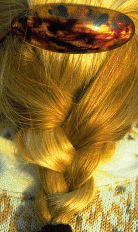
3
3 is a prime number.
= 1 + 2
A triangular number.
1, 1, 2, 3, 5, 8, 13...
A Fibonacci number.
1, 3, 4, 7, 11, 18, 29...
A Lucas number.
A triad, triplet, trio, tern or hat-trick...
Tri- means three. So triangles have three sides, tripods have three legs and the dinosaur triceratops had three horns. The French flag is a tricolore because it has three colours. Trigonometry is a branch of mathematics based on measuring triangles.

A triangle of triangles in the MOT test sign.
Three-dimensional means that something has length, width and depth.
There are three school terms in a year.
Oaths are traditionally repeated three times.
A three-legged race is run by two people each with a leg tied to their partner's.
The letters A F H K N Y Z are all made up of three lines.
There are three barleycorns in an inch, three feet in a yard, and three miles in a league. Barleycorns and leagues are some old imperial units of length which are no longer used today.
Once upon a time there
were three little pigs ... three billy goats gruff ...
Stories often begin this way and have a similar structure. Number one
and number two are always similar so the listener is lulled into believing
number three will be the same. But with number three there is a twist
in the tale.
In Greek mythology you will find Cerberus, a three-headed dog, and Scylla, a sea monster with six heads. It is curious that mythological heads are inclined to come in multiples of three.
With just a ruler and a pair of compasses, it is possible to divide any angle exactly in half. This is called bisecting an angle. But is it possible to trisect any angle - to divide it in three - using just a ruler and compasses? Hundreds of people have spent hundreds of hours trying to discover a way to do this, without realising that it has been proved to be impossible.

Three-fold symmetry in the tiger flower (Tigridia pavonia).
If the number of petals on a flower is a multiple of three, it is probably from a group of plants called the monocotyledons which includes crocuses, daffodils, tulips, lilies and other plants grown from bulbs.

A tress
of hair originally meant a plait or pigtail with three interwoven strands
of hair.
Most colours can be mixed from just three primary colours. But different primary colours are used for different purposes. For example, all the colours you see on a television screen are mixtures of red, green and blue light. With paint you can mix most colours from just red, yellow and blue pigments. The colours in books and magazines are usually printed from three coloured inks: cyan, magenta and yellow, although black ink is used as well.
We use three primary colours because of the way our eyes work. At the back of our eyes are cells called cones which are sensitive to coloured light. There are three different types of cone, each sensitive to different wavelengths of light. If our eyes were built differently and we had four types of cone cell, we would need to use four primary colours in printing, painting and television.


Left - mixing
colours from red, green and blue as on a television - and right - mixing
colours from cyan, magenta and yellow as in the printing of a book.

